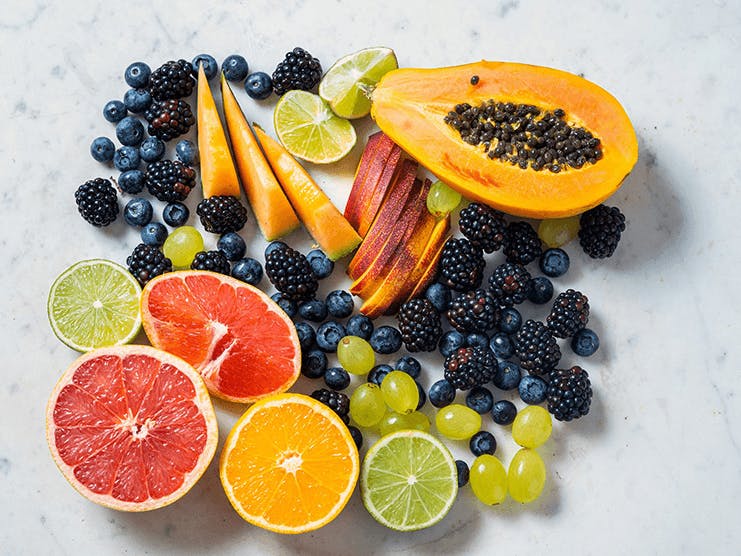
Eating produce may reduce damaging inflammation in the brain and elsewhere in the body. Here are four delicious ways to enjoy more fruits and vegetables.
You’ve heard that an apple a day keeps the doctor away. That popular phrase may not be a scientific fact. But new research shows that an apple a day may help keep dementia away. So will blueberries, peppers, and other brightly colored fruits and vegetables.
A 2021 study published in the journal Neurology found that people who eat at least half a serving a day of these kinds of foods may have a 20% lower risk of cognitive decline.
The researchers followed almost 80,000 men and women for 20 years. They looked specifically at the subjects’ intake of flavonoids, a group of colorful compounds found in plants. And what they found may encourage you to build your foods around a rainbow of hues.
Related reading: The Brain Exercise You Should Do Every Day
Eating fruits and veggies boosts brain health
Flavonoids are antioxidants, which are molecules that neutralize harmful substances in the body called free radicals. Unchecked, free radicals create inflammation. The damage caused by inflammation can lead to several health conditions, including cancer and dementia.
Free radicals act like rust in the brain, says Lisa Mosconi, Ph.D., director of the Women’s Brain Initiative at Weill Cornell Medicine in New York City.
Fortunately, some types of flavonoids can cross the blood-brain barrier. That means they can travel into the brain and search out free radicals there. By removing free radicals, flavonoids protect brain cells from inflammation, says Mosconi.
Given this, the researchers in the Neurology study wanted to see whether people who eat more flavonoids might have long-term cognitive benefits. So they looked at subjective measures of cognitive decline, which often appear before actual dementia. They asked people questions such as:
- Do you have more trouble than usual remembering a short list of items, such as a shopping list?
- Do you have more trouble than usual following a group conversation or a plot in a TV program, due to your memory?
The study found that the more flavonoids a person ate, the less likely they were to feel like they were experiencing memory problems. And the amount needed to make a difference may be lower than you’d think.
“The people who did best [in the study] ate at least half a serving of flavonoid-rich produce per day,” says Tian-Shin Yeh, M.D., Ph.D. She’s the study’s lead author. She’s also an epidemiologist and post-doctoral research fellow in the Harvard-Oxford Program in Epidemiology and Department of Nutrition at the Harvard T.H. Chan School of Public Health.
So half a serving: That’s the number to aim for. And you can get that in half a cup of berries; half an apple, orange, or banana; or a quarter of a grapefruit.
Among the flavonoid-rich foods named in the study:
- Strawberries
- Blueberries
- Oranges
- Apples
- Peppers
- Bananas
- Onions
- Peaches
- Cauliflower
- Brussels sprouts
- Potatoes
- Lettuce
And in general, more color indicates more brain-protecting power. Three subclasses of flavonoids — anthocyanins, flavanones, and flavones — were found to be the most protective. Anthocyanins give berries their deep jewel tones. Oranges and grapefruits are good sources of flavanones. And peppers and celery are rich in flavones. (Here’s how to save money at the supermarket.)
According to Dr. Yeh’s study, high flavone intake translated to a 38% reduction in risk of cognitive decline. That’s like being three to four years younger.
Speaking of age, Dr. Yeh says it’s never too late to start eating more produce to see brain benefits. “We found better cognitive function whether people were consuming the flavonoids 20 years ago, or if they started incorporating them more recently,” she says.
Eating to protect your memory
Yes, eating brightly colored food is good for you. But eating food only for color could backfire, says Dr. Yeh.
Mushrooms, for instance, are one of the few sources of vitamin D in the plant world. Millions of Americans need more vitamin D. But mushrooms don’t have much color, and by extension, they don’t contain flavonoids.
So build a colorful plate, but rather than focusing only on specific fruits or veggies, aim to increase the variety, says Dr. Yeh. Aim to eat at least five servings of fruits and vegetables a day. And get a motley mix of reds, oranges, greens, and purples.
To help, here are four ways to make sure you have a produce rainbow in your day:
1. Sprinkle berries on your favorite meals and snacks
They taste great on everything from oatmeal and Greek yogurt to salads and salmon.
And in case you're wondering, frozen are as healthy as fresh. “Because they are picked and preserved at peak ripeness, frozen berries may be higher in flavonoids and vitamin C than fresh berries,” says Ilana Muhlstein, a Los Angeles–based nutritionist.
2. Drink a smoothie
Smoothies are a simple, tasty way to eat flavonoid-rich fruits and veggies every day. Marla Feingold, a licensed diet nutritionist and certified nutrition specialist in Chicago, recommends adding a cup of kale or a cup of blackberries or blueberries to your morning smoothie.
3. Add different-colored bell peppers to your stir-fries or fajitas
A 2019 study researched a possible link between bioactive compounds, including flavonoids in sweet peppers, and Alzheimer’s disease. The study showed that different colors of peppers contain different types of flavonoids. That’s why Megan Meyer, Ph.D., suggests adding all kinds of colorful peppers — red, orange, yellow, and green — to your favorite dishes. Meyer is the senior director of science communications for the International Food Information Council in Washington, D.C.
4. Sneak cauliflower into meat dishes
Despite its lack of vibrancy, cauliflower is a good source of flavonoids. Plus it provides fiber and iron, Muhlstein says. She recommends making healthier burgers by mixing a pound of your favorite ground protein with a pound of riced cauliflower: “Now you’re eating burgers that are half veggie, but you can barely tell the difference.”
Additional sources
“A Review of Mushrooms as a Potential Source of Dietary Vitamin D”
External Website Link
USDA Agricultural Research Service.
External Website Link
“Vitamin K Fact Sheet for Health Professionals”
External Website Link


